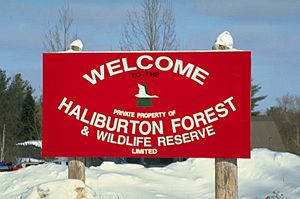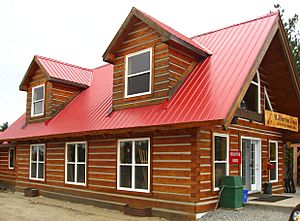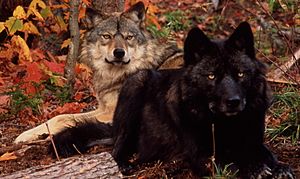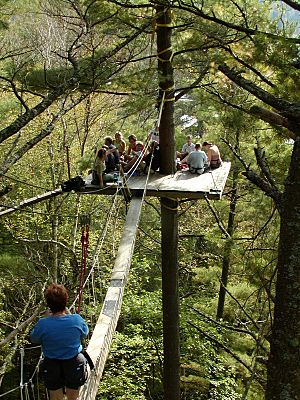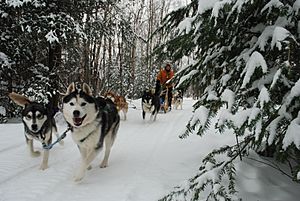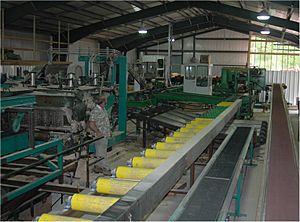Haliburton Forest facts for kids
The Haliburton Forest & Wild Life Reserve Ltd. is a huge private forest in Haliburton County, Ontario, Canada. It covers about 300 square kilometers (116 square miles). This amazing place is located about 270 kilometers (168 miles) northeast of Toronto, right next to Algonquin Provincial Park.
Haliburton Forest is a "multi-use forest," meaning it's used for many different things. You can find exciting attractions like the Haliburton Forest Wolf Centre and a cool canopy walk. It even has the world's only freshwater tour submarine! The forest offers fun recreation, tourism, and education programs all year round. Its forestry operations were the first in Canada to be certified by the international Forest Stewardship Council, showing they manage the forest in a very responsible way. Haliburton Forest also supports research projects about ecosystems, mostly done by the University of Toronto's Faculty of Forestry.
Contents
A Look at the Forest's History
The land that is now Haliburton Forest was first surveyed in the winters of 1862 and 1863. Later, in 1885, a company from London called the Canadian Land and Emigration Company bought a large part of this land. They hoped to sell it to British families as farmland.
However, their plans didn't work out. Most of the land wasn't good for farming. So, the company changed its name to the "Canadian Land and Immigration Company."
From 1870 to 1910, big lumber companies bought rights to cut down trees here. They cleared most of the tall white pine trees.
By the 1930s, a company called Algonquin Corporation owned a lot of the land. They kept harvesting timber until 1946. After that, another company continued cutting down many trees until 1971. Most of this timber came from the land that is now Haliburton Forest.
In 1962, a German Baron named von Fuerstenberg bought the property. He renamed it Haliburton Forest and Wild Life Reserve Ltd. The way trees were cut changed a lot after this. Instead of taking the best wood, foresters started removing lower quality and older trees. This helps the forest grow back healthier and stronger for the future.
Fun Activities at Haliburton Forest
Haliburton Forest offers many exciting activities for visitors of all ages.
Fishing in the Forest Lakes
Several lakes inside the forest are home to native fish like brook trout and lake trout. Four lakes (Stocking Lake, Dutton, No Name Lake, Wildcat Lake) are special because brook trout naturally reproduce there, which is quite rare!
You can also find several bass fishing spots. Kelly and Johnson Lake are easy to reach, while Gadwall and Powderhorn lakes are a bit more challenging to get to.
Discovering the Wolf Centre
The Wolf Centre opened in July 1996. It's home to a pack of five timber wolves (Canis lupus). They live freely in a very large enclosure, which is one of the biggest in the world. The wolves are fed about once a week, so they often hang out near the viewing area. This spot is close to the highest point in their home and a water source, so you might get a good look at them!
Walking High on the Canopy Tour
This amazing experience is called "A Walk in the Clouds." It starts with a guided van tour through the private lands of Haliburton Forest. You'll see beautiful forests, lakes, and streams. Then, you'll take a short walk along the scenic Pelaw River. After that, you'll enjoy a short canoe ride across a wilderness lake to reach the Canopy Boardwalk. It's a truly unique way to see the forest from above!
Thrilling Snowmobiling Adventures
Haliburton Forest is the only privately owned snowmobiling operation in the world! It has 80,000 acres of forest wilderness, 50 lakes, and many ponds and creeks. The main trail system is about 300 kilometers (186 miles) long and is wide enough for two snowmobiles side-by-side. There are also smaller trails that lead to more remote areas. You'll find several shelter cabins along the trails, complete with stoves and firewood.
Exciting Dogsledding Tours
You can go dogsledding at Haliburton Forest on groomed winter trails. They have over 130 Siberian Huskies! You can choose from introductory, half-day, or full-day tours. Professional guides will teach you the basics of dogsledding.
Mountain Biking Trails
Bikers have many choices here! You can ride on access roads, forest trails, or even a route that covers some of the toughest terrain in the Province. The cycling season runs from Victoria Day weekend to the weekend after Thanksgiving.
Stargazing and Astronomy
Haliburton Forest is a fantastic place for stargazing. It's located far from city lights, making it part of the Algonquin Dome. This means you can see stars, galaxies, and other deep sky objects that are usually hidden by light pollution in cities.
The Forest Observatory
The observatory is on a small hill near the forest entrance, giving it a clear view of the night sky. When the roof rolls off, you can see telescopes and other astronomy equipment inside. The ground floor is used for presentations.
The observatory has two 10-inch and one 12-inch Schmidt-Cassegrain telescopes. These telescopes can track objects in the sky by themselves and have computer functions that can find over 64,000 different objects!
Sawmill Tours
The new Haliburton Forest sawmill opened to the public in 2010. There's a platform that overlooks the working mill, so you can safely watch how trees are turned into lumber.
The Annual Forest Festival
The yearly Forest Festival brings together performing and visual arts within the beautiful setting of Haliburton Forest and Wild Life Reserve. It's a great way to enjoy art and nature at the same time!
Caring for the Forest: Conservation and Forestry
Haliburton Forest is privately owned, and it tries to find a good balance between running a successful business and using its resources in a way that protects them for the long term. Over the past 40 years, its 70,000 acres have changed from a forest that was over-harvested to a place that is used for many things. This helps both the economy and the environment of the local community.
Haliburton Forest was the first forest in Canada to be certified as a "sustainable forest." This means it follows strict rules from the international Forest Stewardship Council (FSC) to ensure the forest stays healthy for generations to come.
EcoLog Homes and Sustainable Wood
EcoLog Homes builds and supplies log home kits. The logs they use come from the 70,000-acre Haliburton Forest & Wildlife Reserve Ltd. Each season, mature hemlock trees are ready for harvesting, some as wide as thirty inches! Each tree is carefully cut down and moved by horse to the nearby Haliburton Forest Mill. There, the wood is shaped into timbers for homes or sawn into boards. This shows how the forest's resources are used responsibly.
|


